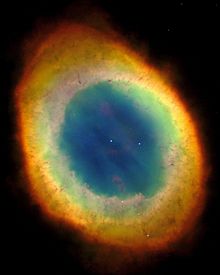Emission nebula
This article has multiple issues. Please help improve it or discuss these issues on the talk page. (Learn how and when to remove these messages)
|

An emission nebula is a nebula formed of ionized gases that emit light of various wavelengths. The most common source of ionization is high-energy ultraviolet photons emitted from a nearby hot star. Among the several different types of emission nebulae are H II regions, in which star formation is taking place and young, massive stars are the source of the ionizing photons; and planetary nebulae, in which a dying star has thrown off its outer layers, with the exposed hot core then ionizing them.
General information
Usually, a young star will ionize part of the same cloud from which it was born, although only massive, hot stars can release sufficient energy to ionize a significant part of a cloud. In many emission nebulae, an entire cluster of young stars is contributing energy.
Stars that are cooler than around 25,000K don't give off enough ultraviolet radiation with wavelengths shorter than 91.2nm (the wavelength needed in order to ionize Hydrogen atoms). This results in the reflection nebulae around these stars to give off more light than the emission nebulae. Stars that are higher than 25,000K generally give off enough ultraviolet radiation to cause the emission nebulae around them to be brighter than the reflection nebulae.[1]
The nebula's color depends on its chemical composition and degree of ionization. Due to the prevalence of hydrogen in interstellar gas, and its relatively low energy of ionization, many emission nebulae appear red due to strong emissions of the Balmer series. If more energy is available, other elements will be ionized, and green and blue nebulae become possible. By examining the spectra of nebulae, astronomers infer their chemical content. Most emission nebulae are about 90% hydrogen, with the remaining helium, oxygen, nitrogen, and other elements.
Some of the most prominent emission nebulae visible from the northern celestial hemisphere are the North America Nebula (NGC 7000) and Veil Nebula NGC 6960/6992 in Cygnus, while in the south celestial hemisphere, the Lagoon Nebula M8 / NGC 6523 in Sagittarius and the Orion Nebula M42.[2] Further in the southern hemisphere is the bright Carina Nebula NGC 3372.
Emission nebulae often have dark areas in them which result from clouds of dust which block the light.
Many nebulae are made up of both reflection and emission components such as the Trifid Nebula.
Image gallery
See also
References
- ^ "20.3 Cosmic Dust - Astronomy | OpenStax". openstax.org. Retrieved 2022-02-15.
- ^ McArthur, Frommert; Kronberg, Christine (12 April 2006). "Messier 42". Messier Object Index. Retrieved 17 July 2007.
- ^ "A Beautiful Instance of Stellar Ornamentation". Retrieved 19 May 2016.
- ^ "Hubble revisits the Monkey Head Nebula for 24th birthday snap". ESA/Hubble Press Release. Retrieved 10 April 2014.
- ^ "Cosmic Silver Lining". Retrieved 21 May 2021.

![Emission nebula LHA 120-N 55 in the Large Magellanic Cloud.[3]](http://upload.wikimedia.org/wikipedia/commons/thumb/9/9a/The_glowing_gas_cloud_LHA_120-N55_in_the_Large_Magellanic_Cloud.jpg/114px-The_glowing_gas_cloud_LHA_120-N55_in_the_Large_Magellanic_Cloud.jpg)
![Hubble image of emission nebula NGC 2174.[4]](http://upload.wikimedia.org/wikipedia/commons/thumb/6/62/New_Hubble_image_of_NGC_2174.jpg/120px-New_Hubble_image_of_NGC_2174.jpg)
![Hubble image of emission nebula NGC 2313.[5]](http://upload.wikimedia.org/wikipedia/commons/thumb/a/a7/Cosmic_Silver_Lining.jpg/120px-Cosmic_Silver_Lining.jpg)